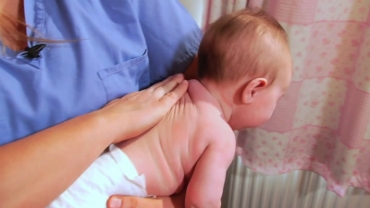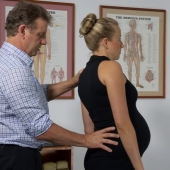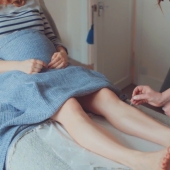During the nine months of pregnancy, your body goes through many hormonal and physical changes. These changes occur quickly, and include stretching of muscles, softening of ligaments, and loosening of joints to make room for the baby and help you during labor.
Upper and lower back pain is a common complaint during pregnancy, especially during the later months. This pain can interrupt your sleep, and interfere with your daily activities. Good posture and proper body mechanics will help you to minimize these complaints, and reduce the severity or frequency of this discomfort.
Changes that can occur while pregnant or postpartum:
- Tight Back Muscles
- Increased Spinal Curves
- Low Back Pain
- Tight Leg Muscles
- Head/Shoulders Move Forward
- Ankles May Swell
There are ways to practice good posture to reduce the strain on your muscles and your joints. Try to check your posture every time you move or adjust your position. Since your muscles support your body all day, when you use good posture, you give them a little rest.
Standing Posture: Incorrect posture puts stress on your hips, back, and legs. When you stand, try to keep your pelvis level, and try to align your ears, shoulders, hips, and ankles. Keep your weight equally distributed on both legs. Pull in your belly to support your low back.If you are doing work over a sink or counter, you may want to use a foot stool, or use a cabinet ledge to take the pressure off your back.
Sitting Posture: During your pregnancy, your belly gets bigger, and there is an increased strain on your back. When sitting in a chair, avoid slouching. Use a pillow or towel roll behind your low back to give you more support. Try to keep your knees level with your waist. When getting out of chair, scoot to the edge of the chair, make sure your feet are under you, and lean forward. You may need your hands to help push you to stand.
You may need more room to get up safely now. If you're in the car, push the seat back to allow room for your legs to swing to the side. Turn your whole body, scoot to the edge of the seat, lean forward, and use your legs to get up.
Sleeping Posture: You may find it hard to get comfortable when trying to sleep or relax, especially towards the end of your pregnancy. While lying on your back, use pillows under your knees to help to help support your lower back. Lying on your back can result in dizziness, lightheadedness, or shortness of breath, because your uterus is pushing on the vein that returns blood to the heart. Avoid sleeping on your back after your 16th week. After your 16th week, sleep on your side.
When you are sleeping on your side, make sure you are maintaining good body mechanics. Use enough pillows under your head to support your neck. Put one or two pillows between your knees, and under your abdomen to support your belly, and keep your body aligned.
Getting in and Out of Bed: Practicing good body mechanics as you change positions is important to prevent injury. It may become more difficult to get in and out of bed, so move carefully. To get up from bed, start on your side, and let your legs come off the bed while you are pushing up with your hands. Don't let someone pull you up to get out of bed, as this may strain your back, shoulders, and abdominals. Get up slowly to avoid feeling faint or dizzy. Don't use your arms to push up out of bed or to lie back down. When you are getting back into bed, start by sitting at the edge of the bed, slowly lift your legs up onto the bed, and lie on your side.
Pushing: It is important that you do not bend over or lean forward to push things. Keep the object you are moving close to you. If you are sweeping or mopping, bend your knees, and use your legs to push the object, rather than your arms.
Lifting: It is harder to lift correctly as your baby grows. You may also feel more unstable as your center of gravity moves forward with your expanding belly. Now is the time to learn correct lifting habits. When lifting objects off the floor, bend your knees, keep your back straight, and tighten your abdominals as you lift. Use your legs to lift, rather than your back.
Reaching: It is important to protect your loosening joints when you are reaching. Do not twist, as this can strain your back. Instead, turn your entire body and your feet when reaching. Ask for help if you cannot reach an object.
Pregnancy Support Belt: A pregnancy support belt can be worn during your pregnancy if you are experiencing back pain. After you have delivered, it takes a while for your muscles to recover. Proper posture and body mechanics are still important to prevent injury and back pain. Here are some additional suggestions for helping you after the baby has arrived.
Carrying the Baby: After delivery, your abdominal muscles are still weak, and susceptible to injury. Always be careful when lifting and carrying your baby. When you carry your baby on one hip, you are twisting your spine.This can cause increased stress on your back, and increased discomfort. When carrying your baby, place the baby close to your body. If you are holding your baby over one shoulder, be careful to not lean back. By tightening your abdominals, you can help support your spine, especially as the baby grows bigger. A good option, whenever you can, is to use a front baby carrier for the first several months. Then you can switch to a back baby carrier when the baby can support his head.
Carrying a Car Seat from Car: When carrying a car seat, keep it close to your body, and use both hands to carry. Don't lean back, and don't hold it to one side. When you are looking for a baby stroller, find one with an adjustable handle. When lifting a car seat, bend your knees, keep your back straight, and tighten your abdominals as you lift. Use your legs to lift, rather than your back.
Breastfeeding Posture: When breast feeding your baby, use enough pillows to support the baby on your lap. Avoid bending over the baby, or rounding your shoulders. Bring your baby to your breast, rather than bringing your breast to the baby.
- 1991 views













